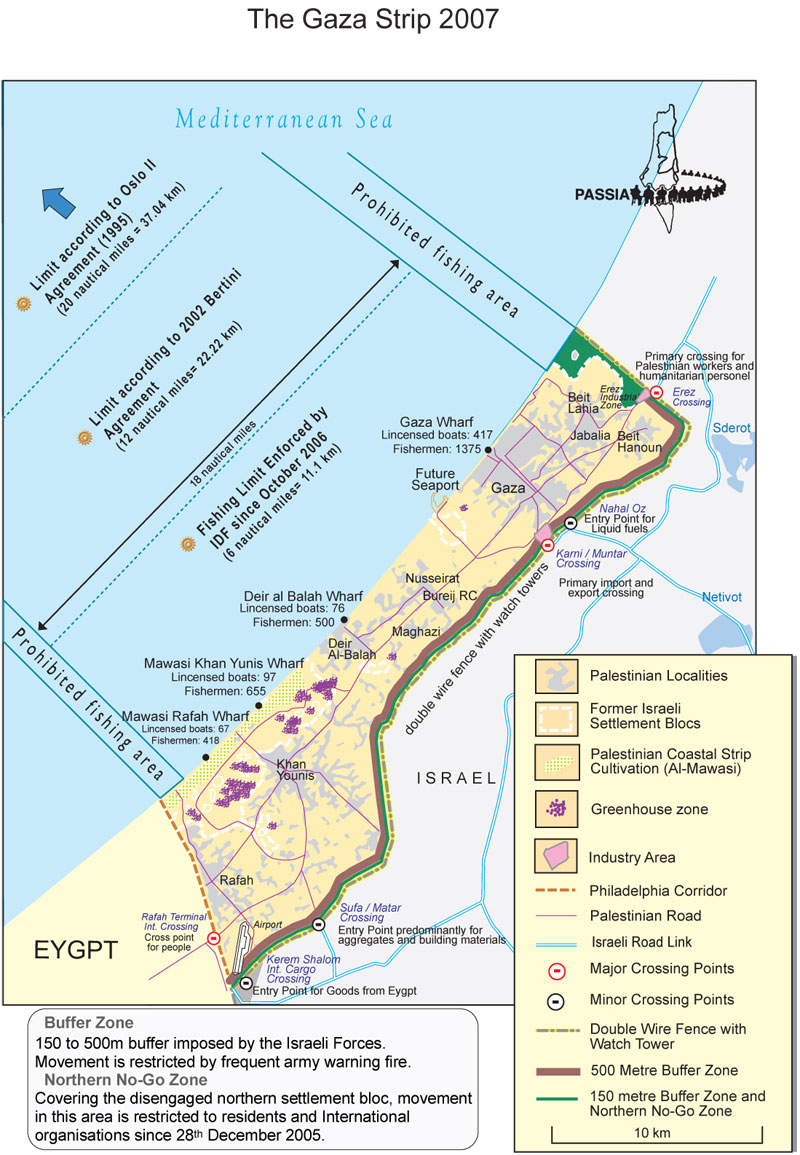(Above) Gaza is part of the territories under military occupation by Israel since the Six Day War of 1967. Although Israeli settlers and troops were withdrawn from Gaza in 2005, it is still considered occupied territory under international law because Israel still controls the lives of the inhabitants of Gaza. Israel maintains a blockade by land and sea on three sides. Egypt controls a small portion of Gaza’s border, to the south, in cooperation with Israel and Israel’s primary protector state, the USA; Egypt is the world’s second largest recipient of US aid.
By sea, Gazans are blockaded by the Israeli Navy. Gazan fisherman may travel only to the first dotted line seen on this map, an area that falls far short of the distance agreed under the Oslo Accords and that has become insufficient for them to maintain their livelihoods. Fisherman are frequently confronted and even attacked by the Israeli Navy.
Humanitarian ships that have tried to break the blockade of Gaza have also been attacked by Israel. Learn more about the Freedom Flotillas here.
The circles on the land borders in this map show the checkpoints which are the only places Gazans may exit their territory or by which goods can be brought into Gaza. Since the massive Israeli assaults on Gaza – Operation Cast Lead in December 2008-January 2009, Operation Pillar of Defense in the summer of 2012, and Operation Protective Edge in the summer of 2014 – the materials needed to rebuild tens of thousands of destroyed homes, as well as hospitals, utilities providers, schools, and businesses, are not being allowed into Gaza. The United Nations has repeatedly called for additional aid for Gazans and for a loosening or end to the blockade. The UN estimates that 80% of the people in Gaza are dependent on humanitarian aid for survival, and 90% of the ground water in Gaza is unfit for human consumption. The World Bank puts Gaza’s unemployment rate at 43%, the highest in the world. Gaza’s only power plant has been damaged repeatedly by Israeli bombardment and can provide electricity for Gazans only a few hours a day.
In 2016, Gaza’s population reached two million, making it one of the most densely populated areas on earth; it has often been called “the largest open-air prison in the world.” Besides severely limiting entry of food, water and other essential resources, as well as desperately needed building materials, the imprisonment of Gaza denies patients access to urgent medical treatment beyond their territory, keeps students from pursuing educational and career opportunities abroad, divides families who are located in Gaza and the West Bank, and prohibits the international community, including the press, from adequately monitoring and reporting on this continuing humanitarian disaster.
Israel always cites the actions and statements of Hamas, the governing party in Gaza, as justification for its repeated and merciless bombardments and its decade-long blockade of the population that it hold captive in this territory. Nevertheless, it should be clear to principled observers that no actions by a government or militant group could justify this brutal collective punishment of two million imprisoned people.
Resources




